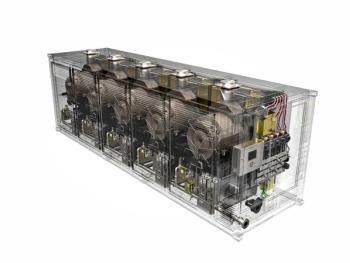
CO2 compression
Benefits of supercritical CO2 (SCO2) turbines: Simple cycle efficiency above 50%; footprints one hundredth of those of traditional turbomachinery for the same power output; and no nitrogen oxides (NOx) emissions.
(A supercritical CO2 turbine design by Dresser-Rand)
These turbines are now well along in the design and prototyping stage.
It may represent the next great frontier in turbine engineering. While steam turbines dominated much of the 20th century, gas turbines (GTs) absorbed most of the R&D resources and gradually came into their own, pushing plant efficiencies from the thirties into the sixties via combined cycle technology.
Similarly, SCO2 turbomachinery requires innovative designs because it is very dense compared with the working fluid in GT’s and steam turbines. Therefore, turbines designed for SCO2 can be roughly 1/100th the size as steam turbines for the same power output. That’s why Closed Brayton Cycle (CBC) technology like SCO2 has been considered for applications with severe volume constraints, such as ships, spacecraft, and lunar power plants.
Many of the major research bodies such as Sandia National Labs, Lawrence Berkeley National Laboratory and Southwest Research Institute (SwRI) are putting a lot of emphasis on SCO2. They are involved with companies such as Toshiba, Echogen, GE and Barber-Nichols in creating these next-generation turbines, though few details have emerged. What is clear is that different components and technology options will have to be considered as the manufactured systems scale upward.
Given the pressures involved and high density (low volumetric flow rate), no GT or steam turbine modification could be made to work. Neither comes even close to the energy density of CO2 turbines and compressors which have energy densities that are in the range of rocket engine turbo-pumps.
However, barriers remain. Heat exchanger technology, for example, is something of a stumbling block, either in terms of cost, footprint or ability to withstand high pressures. But companies such as Heatric and Thar Energy are hard at work solving these issues. In addition, existing systems remain too small to be considered commercially viable.
Some estimate, though, that larger scale commercial models will hit the market as early as next year.
(More in the September/October, 2012 issue of Turbomachinery International)
Newsletter
Power your knowledge with the latest in turbine technology, engineering advances, and energy solutions—subscribe to Turbomachinery International today.




